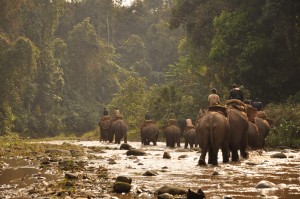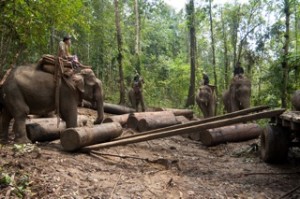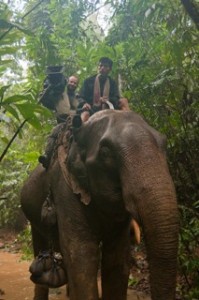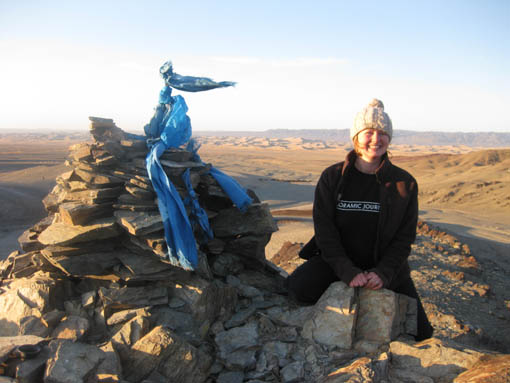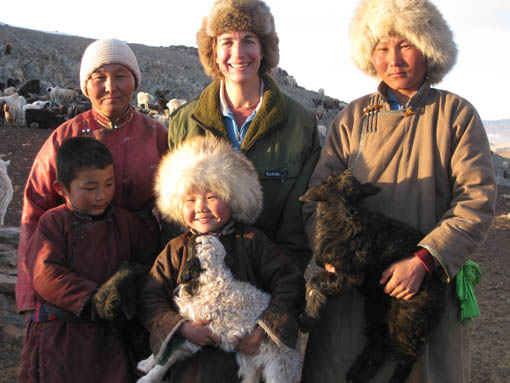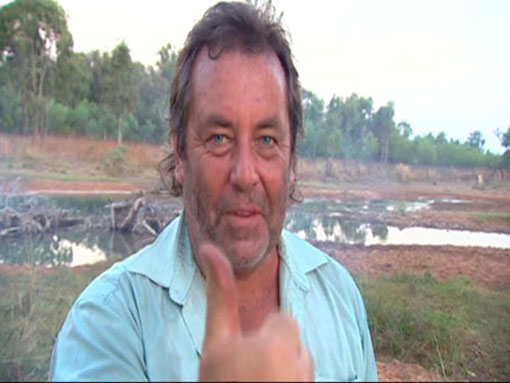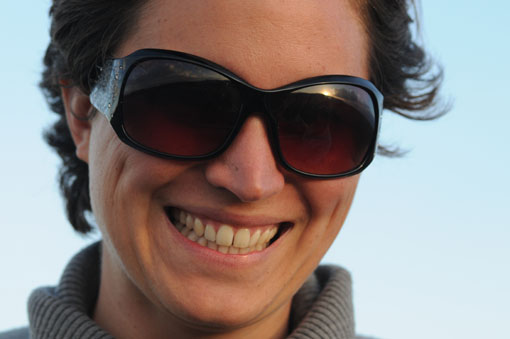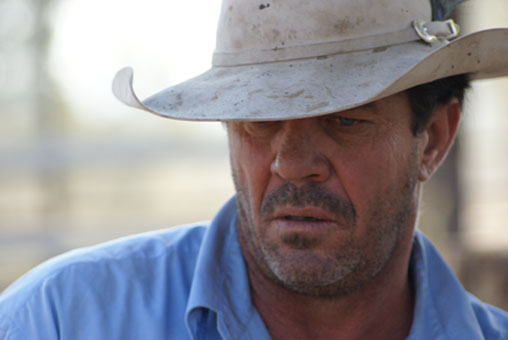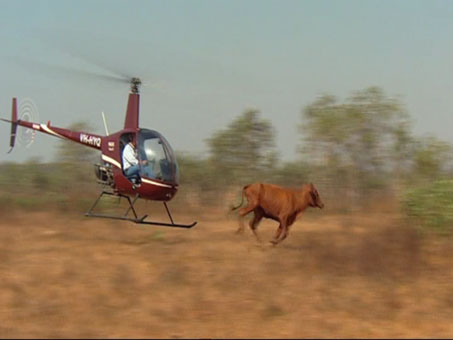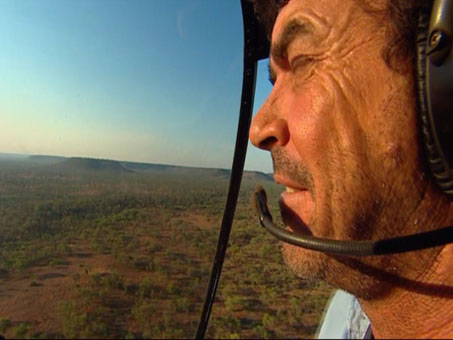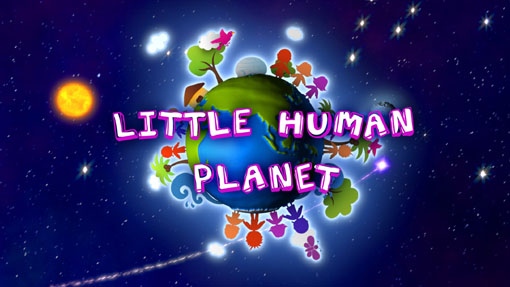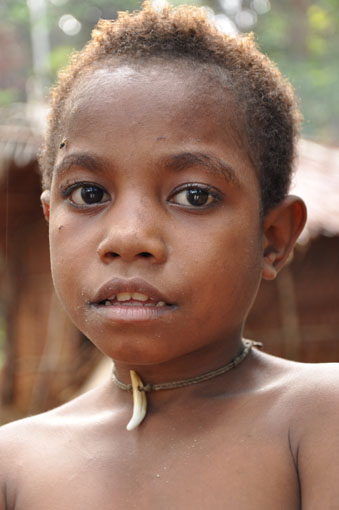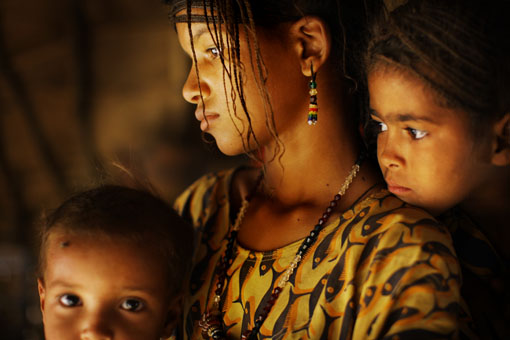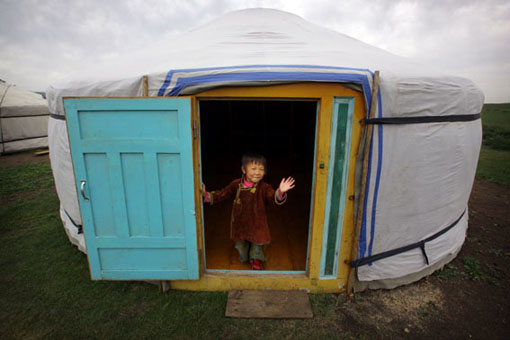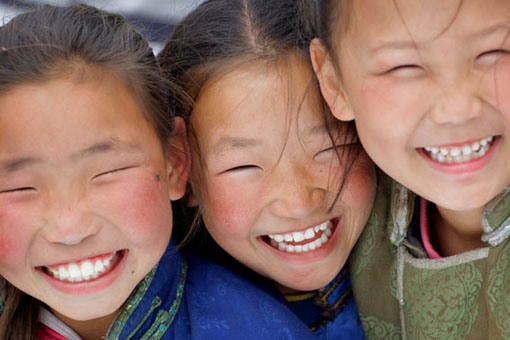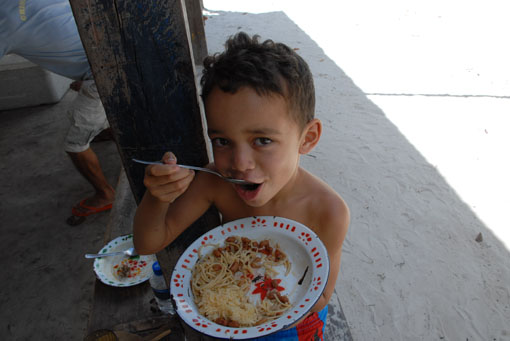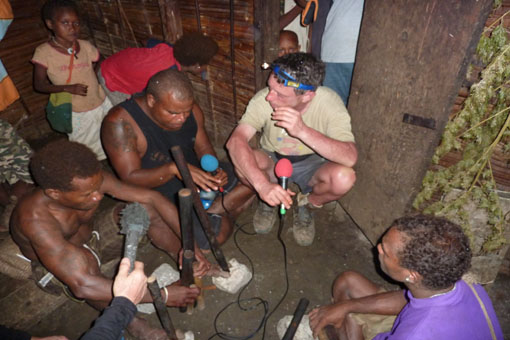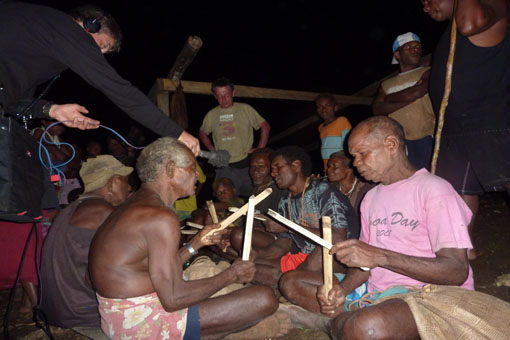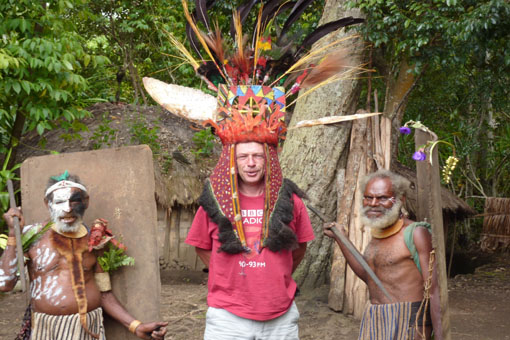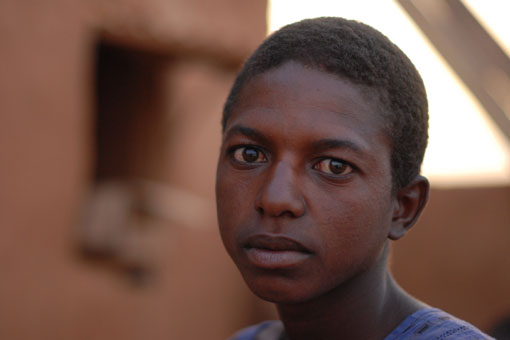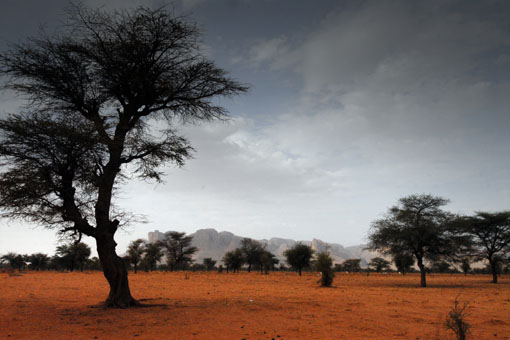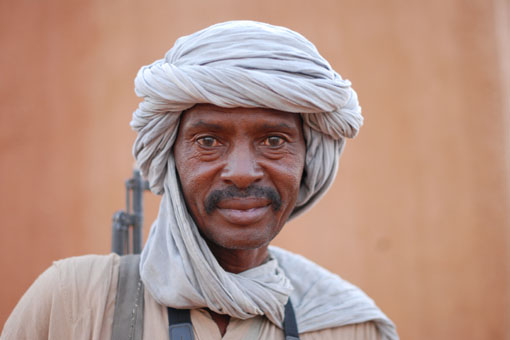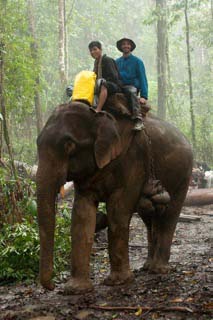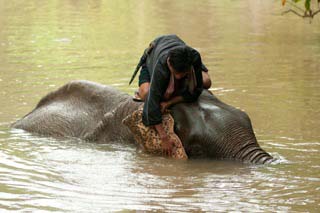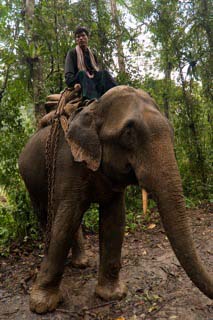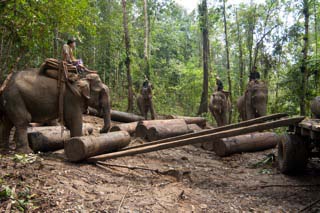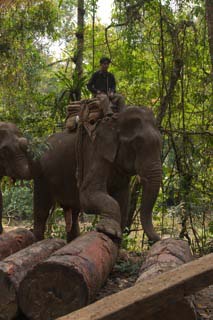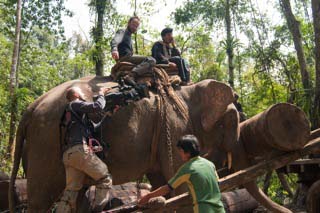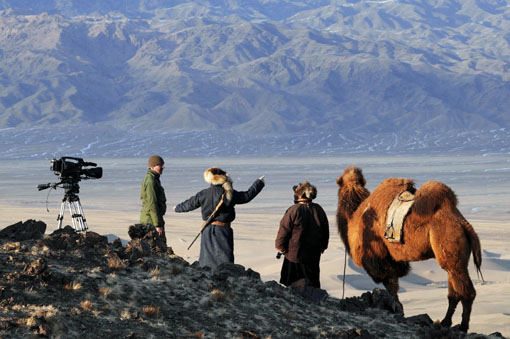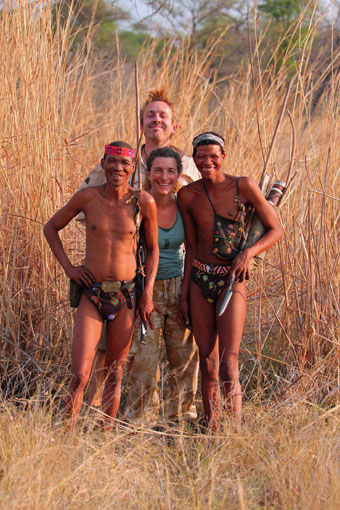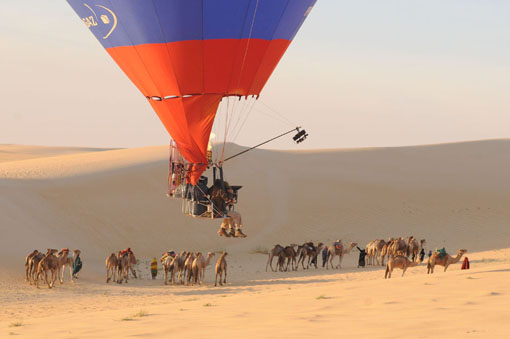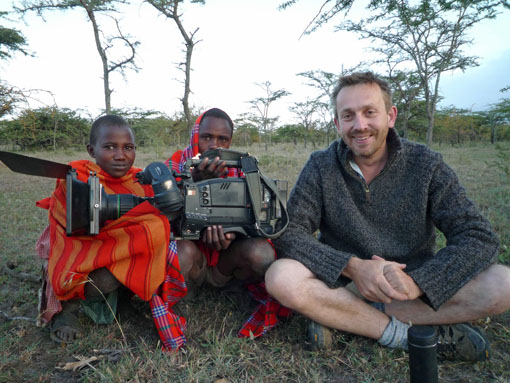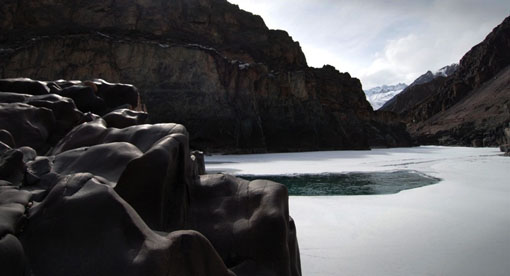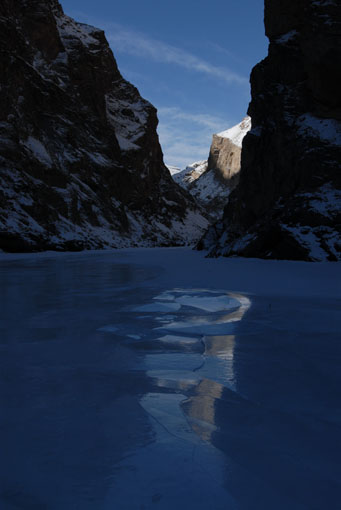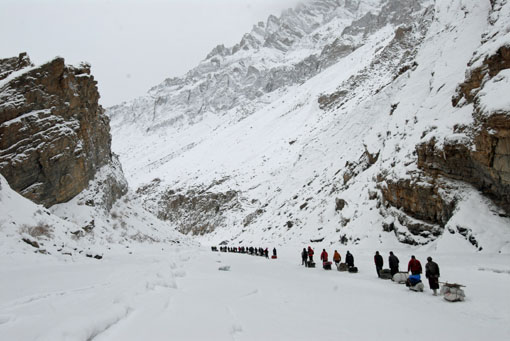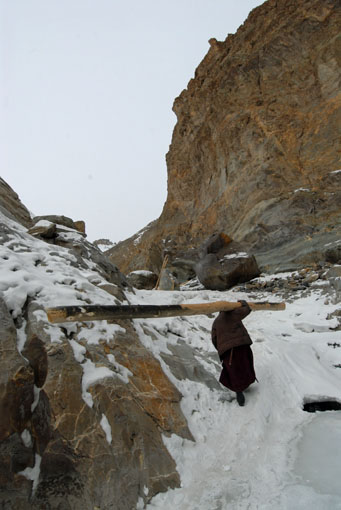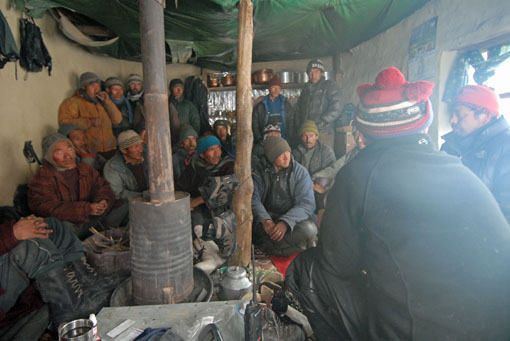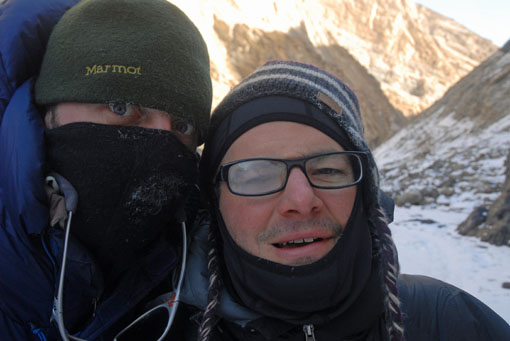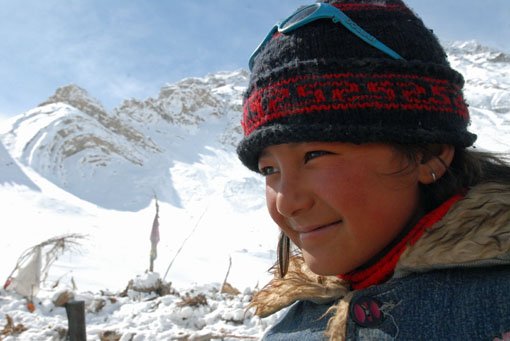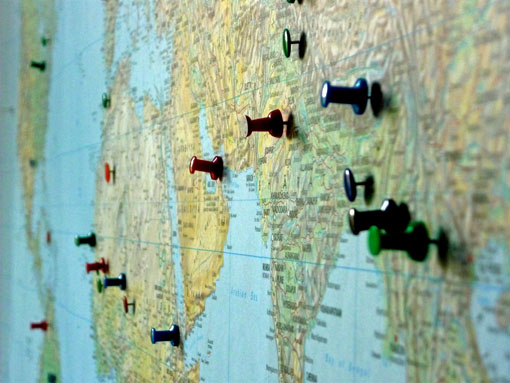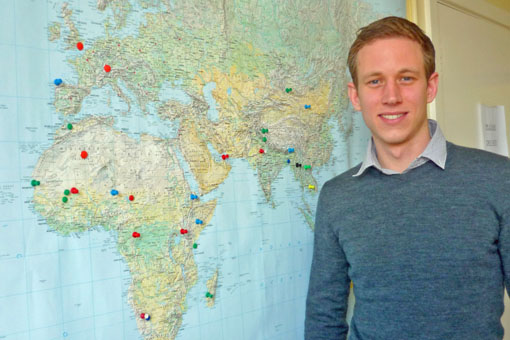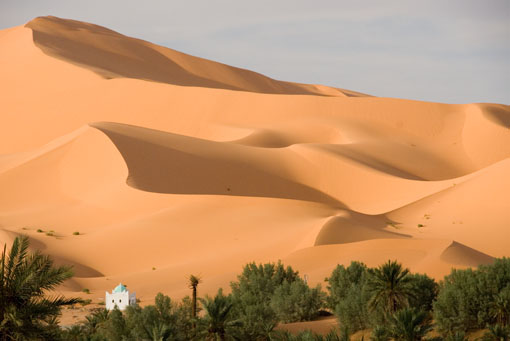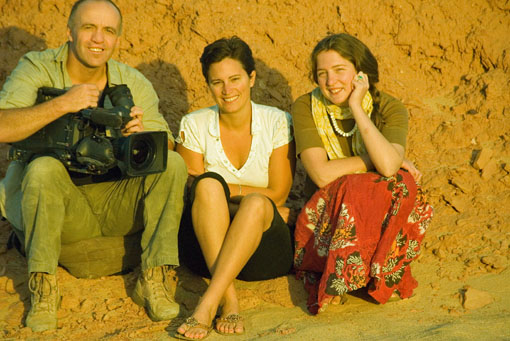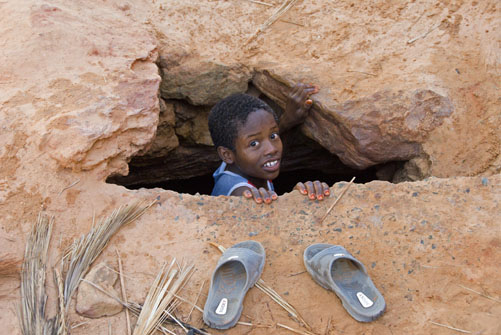The Original Jungle and its Mighty Beasts
By Rachel Kinley, Assistant Producer of Human Planet
The word Jungle itself comes from the Sanskrit word for forest. It was in this original jungle, on the borders between India and Burma, that we filmed people working with one the most iconic of jungle animals – the forest elephant.
It took us three days and several forms of transport, including a rickety old logging truck, to reach the camp which would be our home for the next two weeks. There wasn’t just us staying there though, this camp was home to a dozen elephants and their mahouts.
We were there to film them moving felled trees from the forest, as part of a sustainable logging business. Watching the elephants at work was so impressive. They are powerful beasts who can move a massive log as if it was a tiny twig. Amazing!
Being so strong, they really intimidated me at first. After we’d filmed with them for a while though, I realised that that their mahouts were well in control of these animals. So, when I was offered the chance, I jumped at the opportunity to take one for a ride. I was only allowed to travel on the female elephants so as not to spook the bulls. Our cameraman Robin however was game to ride any elephant any which way, and even learnt how to steer it along with his feet!
Spending time with these mahouts who dedicate their lives to looking after these animals was an empowering experience. This sequence really shows that the Human Planet Jungles programme isn’t just about living in rainforests, it’s about the incredible relationships people have with their environment and the species which live within.
The Human Planet Jungles and Grasslands episode can be seen on the Discovery Channel.
15 Minutes of Fame Across the World
by Karina Moreton, Mongolian Fixer, Human Planet
The Human Planet series is made up of over 70 individal stories, each several minutes in length. As many of you will have gathered from the “Behind the Lens” snippets at the end of each episode, filming these sequences is never easy. Not only were there the challenges of the film crew – such as how to deal with ice melting; cliff edges and tides turning, there are the stories of the people portrayed. For some of them, the whirlwind of a film crew living with them was years ago now and they have gone about their daily lives since. Now that the series is out, will anything change for them?
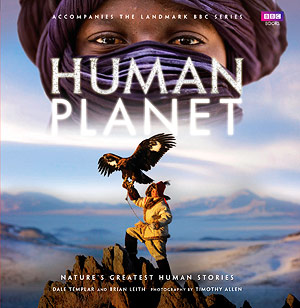
Berik from Human Planet's Mountains programme features on the book's cover
Berik from the Mountains programme is 16 years old. This is him and his eagle on the front of the book that accompanies the series. The book and programmes will be distributed worldwide and it’s hoped they will reach a huge audience. This is more than 15 minutes of fame! Around the world there is a culture of stardom – what would the teenagers from ‘Fame Academy’ and other talent shows give for this exposure? Some could worry that it might go to his head.
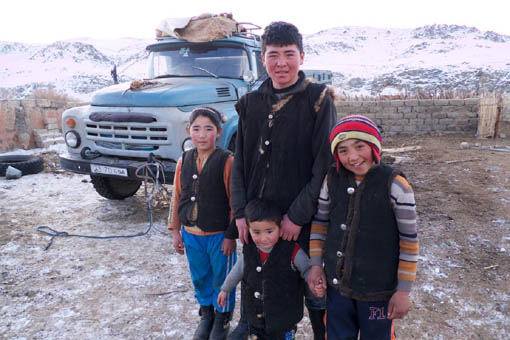
Berik with his cousins at his family home in Altansogts (image copyright Dina Mufti)
I’d like to show a photo or a clip of Berik looking at the book or DVD and giving his reactions. This however isn’t possible. Although copies of the book are on the way to Berik, they will take another 40 days to reach him. ’Outer’ Mongolia is considered to be the back of beyond, and Berik lives in one of the most remote parts of the country. I don’t anticipate that Berik will be exposed to his ‘fame’ until the next Eagle Festival.
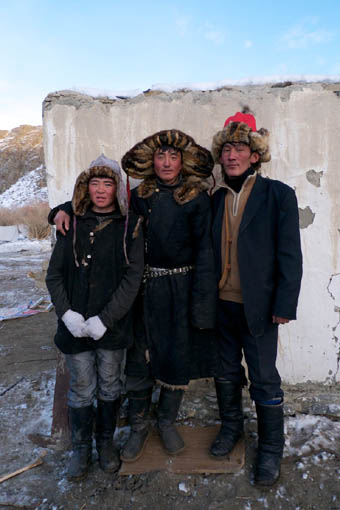
Berik with his older eagle hunting friends … before his first big hunt. (Image copyright Dina Mufti)
I think initially it will be the pages they feature in that will be the most thumbed through, though, with time, the other pages will be the ones that hold their attention. Over the last ten years of travelling through Mongolia, I have shown the reindeer herders of the north photographs of the camel herders in the south and I have shown young children photos of wolves and argali, animals that they have only dreamt of. Suddenly through this book, the Kazakh Eagle hunters of Mongolia are connected with not only the horse and camel breeders of central and southern Mongolia, but now they have shared an experience with the narwhal hunters of Greenland, mussel hunters of Canada and the honey gatherers of Nepal.
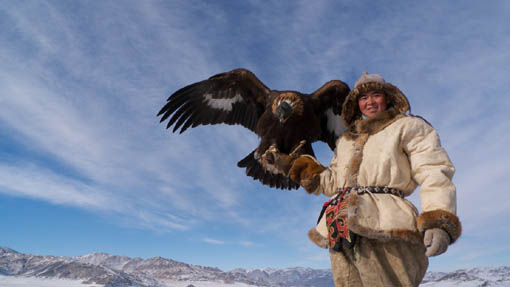
Berik, shortly after he catches his first fox …now officially a 'Kazakh man' (Image copyright Dina Mufti)
Mongolia is a landlocked country, so the images of the sea gypsies in the Pacific will no doubt enthral them. The bird of paradise hunter with his colourful headdress and nose piercing will amuse them. The naked Suri fighters will bemuse them. It is however I believe the story of the falconer in Dubai that will fascinate them. So much in common – for he also trains birds of prey to hunt, and yet they are in such a totally different world. Coming from a country with a rural population density of 0.9 people per square kilometre, it is almost inconceivable for a Mongolian to comprehend what it would be like to live in Dubai where there are 408 people per square kilometre.
Rural urban migration is a problem in Mongolia. Teenagers are attracted to the bright lights of the city. Berik might still be pulled away from his traditional way of life, but I think that perhaps the series will have changed the prospects for him and other young eagle hunters. By hosting occasional visitors who want to experience their culture first hand, this and other communities like them, have a renewed pride in what they do and a much-needed supplementary source of income.
After the characters in the Human Planet series have had their 15 minutes of fame, the book and the DVD will live on and spread their stories around the world. Many of the traditions and practises shown in the series may not survive until eternity.
Perhaps though, unknowingly, by exposing some of the characters to ‘others’ they may have slowed down the demise of man’s diversity?
Too Good to be True
By Karina Moreton
Mongolia has mountains, grasslands and desert, so it was a perfect location for filming some fascinating stories for Human Planet. When I was asked to be the teams’ fixer in Mongolia, I had a ‘pinch me’ moment – here was an opportunity for me to show off the country that I love so much , to producers at the BBC’s Natural History Unit! Armed with maps, photos and anecdotes, we discussed a wide range of potential stories and we settled on a few. Based in the UK , my role is to set up recces and shoots for film shoots. However, I am always trying to dream up ways to get on location myself rather than to be just co-ordinating from the office. The winter Gobi shoot for the Deserts programme promised to be a tricky one, so I wangled my way onto it.
In the weeks up to our arrival, my colleague Esee travelled to the remote South Gobi talking to camel herders about wolves. It was a big ask. We wanted to find a family who were affected by wolves killing their livestock; who had pregnant camels due to give birth during our time there; who lived near the snow line – who looked good on camera… and who were happy for a team of us live with them and film them for a few weeks!
Somehow the amazing Esee found the right candidates - camel herder Ganbold and his family. Once the teams started filming, I had a whole host of questions thrown at me ‘how do we film if the wolf attacks at night without freezing to death?”. One moment we would be discussing the likelihood of a snowstorm in the Gobi desert in the first few weeks of February; the next dealing with the fact that the only town in the South Gobi has run out of firewood.
I am sure the viewers will connect with these warm-hearted people and learn from their daily challenges. It is the moments that weren’t captured on camera that will remain with me – the time when 6 year old Otgonbayar and I shared the very intimate moment of a lamb being born; the serene solitude of his elder sister riding off into the empty desert with their flock; and the giggles shared with the girls in the ger.
Mongolia and her people have captured my heart. I am so happy that audiences around the world will be able to have an insight into the culture and landscapes of this incredible country. Over the years, I have gained so much from the Mongolian nomads I have spent time with. Panoramic Journeys, who I work for, always give back to the families and communities they work with. Ganbold and his family now supplement their income by hosting guests who would like to experience their lifestyle first hand.
Little Otgonbayar was keen to know when the photographs and footage that we’d shot would be seen by them all . I was four months pregnant at the time, and so it was handy to be able to say that the Human Planet book featuring the photos of stills photographer Tim Allen wouldn’t be published until my baby was running. I continue to pinch myself, for although my work for HP has come to an end, Ganbold and his family remain friends. My son is nearly walking now – but I will be returning to the Gobi with The Human Planet book and the series on my laptop very soon.
THE BBC COMES TO THE ‘OUTBACK’
by Phil O’Brien, Fixer
My name is Phil O’Brien and I live in a place called the Northern Territory of Australia. It’s a place you can wind your clock back a few years, have a beer, and live in peace. Spectacular, panoramic and wild, it’s a huge area, and there’s way more cattle live there than people.
I suppose I’ve lived a bit of a gypsy life drifting from job to job, and had my share of adventure and also a little misadventure in this great place. Everything from catching crocodiles to trying my hand at being a drink waiter… and everything in-between. But not so long ago, I got roped into one of the most exciting rewarding experiences of my life, and I’ll never forget the day the BBC film crew came to the ‘Outback’.
The phone rang with a sharp electrified burst, directly over my left ear, was way too early for a bloke that had been drinking beer after beer, some short hours before. Somehow I got the phone to my ear and answered.
The BB who? BB what…eh, excuse me?
Well, the sweet melodic voice of charming BBC Researcher Jane Atkins never missed a beat. ‘We need a ‘Fixer’ she politely announced. Now me being still half cut and not understanding film terminology, did what any respectable citizen of the Northern Territory would have done…hung up and went back to sleep.
During the next few days Jane Atkins followed up with more calls and information, dedicated and relentless in her pursuit of organising the film shoot, which had to be in the heart of Northern Territory cattle country. I tried to explain that Territory cattle country can be hard, merciless and unforgiving …and that was on a good day! But Jane Atkins stuck to her guns, and wanted me to help organise something that was going to be bigger than Ben Hur. What an honour! This wasn’t going to be no ordinary Mickey Mouse documentary, the BBC wanted to get right down in the bulldust and cow dung and film a rip roaring helicopter cattle muster in one of the world’s last frontiers.
It was a big ask, but Jane Atkins had come to the right man.
I knew just about every bloke, every horse, and every anthill in the Northern Territory. I knew that when it comes to cattle, one man had risen to the top and in a tough environment that breeds tough men, that’s no mean feat.
Big bustling ‘Ben Tapp’ was no ordinary legend.
Built like a brick toilet block, Ben Tapp liked to sprinkle horse shoe nails on his muesli…. he knew no fear. Ben Tapp was one hundred percent pure Territory cattleman, and when I told Jane he also flies a helicopter like a man possessed, the stage was set. Ben Tapp took no convincing, he always knew he was a larger than life character and it was only a matter of time before he hit the big screen.
The day finally came and the BBC film crew landed at our humble airport in the Territory capital of Darwin. What a fantastic bunch of people, I thought to myself as the introductions flowed and the pommy accents filled the air. They were a star studded line up, the best in their field. Jane Atkins was even better looking in real life than I imagined and the cameraman was a friendly bloke called Toby Strong. Accompanying them was the director, charming Susan McMillan, and technical assistant and roustabout, Jasper Montana. Sound man Ian Grant who flew in from Queensland. After a flurry of baggage, camera and sound kit, hire cars and groceries, we headed off on our 600 kilometre journey down to Maryfield Cattle Station, home of the legendary Ben Tapp.
Right from the start I really liked their humility; there was no big egos, no pretence, just a great film crew chomping at the bit. Keen to roll it, wrap it, and get it in the can.
We broke our journey after about 300 kilometres at Katherine, just in time to witness a fairly lively punch up between a couple of locals at the petrol station. The BBC film crew weren’t too fussed, they’d been all over the world, and two bantam weights swinging like rusty gates weren’t about to freak them out. Next stop down the track a bit was the one horse town of Mataranka, population 200 [including cattle].
The BBC was starting to get hungry so I steered them over to the Pub. Inside there were people propped up drinking furiously. It was like ‘God’ had personally just rung the pub and told them the world’s ending in half an hour, so get into it. In amongst it all was the publican, a glamorous lady called Deb, wandering around in a beautiful flowing gown, quite a sight in amongst all the rough necks. I introduced her to the BBC film crew. If she’d had a red carpet she would have rolled it out but instead she cooked a great feed of Barramundi and chips for everyone, she was a great host.
With Barra and chips hanging off our ribs we made the last few hours to Maryfield Station and finally everyone had a chance to meet Ben Tapp. It was all very warm, and although Ben is tough, hard, wild and all the rest of it, he is also a very generous bloke, and he totally opened up his house and his property to the BBC film crew, and nothing was going to be too much trouble. Ben’s hospitality really was first class. He was right on the ball, he had 2000 head of cattle to muster and he had his young team of stockmen fully briefed. His right hand man on Maryfield was a bloke called Rankin Garland who also was a gifted chopper pilot. Right from the start everyone really hit it off.
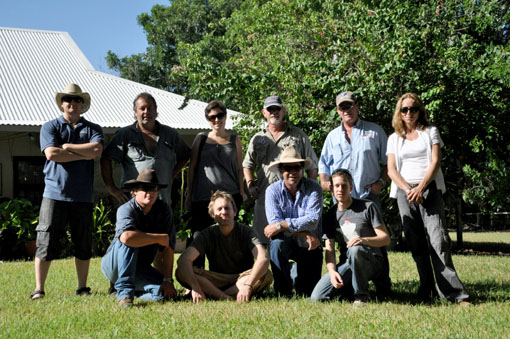
Back Row(from left) Warick Field[Cineflex Camera Operater
The next ten days for me were just unreal, I got to see a world class film crew in action and I was totally inspired. Camera man Toby Strong went from sun up to sundown and still had energy, I remember one time he was hiding in a bush filming cattle as they filed passed, a snake came out of nowhere and slithered over his leg, but he never flinched, he just kept filming. There was no stopping him, where ever the action was, there was Toby.
Susan McMillan was a great director and she brought the best out in everyone, she and Toby made a great creative team. I felt sorry for her a bit because I was doing the cooking for everyone and so all my meals revolved around meat, meat, and more meat, poor old Susan was vegetarian and I can’t actually remember her eating anything the whole ten days. She would have paid big money for a lettuce.
Susan, Toby and Ben communicated really well and as the whole focus was on helicopters and mustering, Ben and Rankin didn’t disappoint. Their aerial work was breathtaking, and Ben really got into the whole film thing. He was actually coming up with great ideas for shots and where to put the camera and what angle and stuff. He was proving very artistic, in an outback type of way. Obviously under that tough, rugged, exterior was a sensitive creative new age guy.
Jane Atkins reminded me of the ‘Holy Spirit’, she was everywhere at once. Unstoppable and three months pregnant, she was the rock of Gibraltar. Jane has such a calm beautiful nature, whether it be out in the hot sun assembling the camera crane, or curled up in front of the computer like a cat, watching over everyone. Technical Assistant Jasper Montana was running around like an unregistered dog, tirelessly helping where he was needed and never complained. Sound man Ian Grant was the total professional as well and spent many hours following cattle around, taping their every bellow.
The only drama was when a Jet Ranger helicopter fitted with a special Cineflex camera that the BBC had hired looked as though it wasn’t going to make it. This caused a bit of concern as the special Cineflex camera was crucial to the whole thing. But Jane, after numerous phone calls and emails, and with a little help from God, made it happen.
After days of filming Ben and Rankin doing their wild manoeuvres in the choppers, and cattle wheeling to and fro through the scrub, it was time for the grand finale. It was time for the big money shot. Two thousand head of disgruntled beef had to be brought in and yarded up. It really was a great spectacle and all the many hours of planning really came off. With the Jet ranger and the Cineflex camera high up in the sky taking in the whole vista, Ben and Rankin set about driving the mob into the yards in their dragonfly-like mustering choppers. Through a veil of dust the choppers weaved, pitching, diving, steering the frenzied mob in towards the yards. On the ground were horsemen and motor bikes turning back any beast that tried to head back to the scrub. Toby Strong of course was courageously right in amongst it all getting some of the best shots I’ve ever seen. Ian Grant, camouflaged in the trees, captured some great sound and everything went off brilliantly. The BBC had won the day!
With the cattle yarded, big bustling Ben Tapp landed and rolled himself a well deserved smoke, it had been tough, but all in a day’s work when you’re a legend.
Next day was the completion of the filming. After a humongous party that night, it was time to pack up all the kit and head back to Darwin to get the film crew on the plane. There was many a teary eye and a hazy hangover as we all said our goodbyes. Friendships were made and it really had been a special time. Whether we ever see each other again who knows?
But one thing I know for sure, the Northern Territory will never forget the day the BBC came to the ‘Outback’.
Little Human Planet
by Elen Rhys, Producer, Little Human Planet
When delightful Dale Templar told me that Human Planet had been commissioned, my brain immediately started working overtime. Waw, what a great opportunity for a children’s spin off on CBeebies. Surely, if they would be filming humans in far flung and remote locations around the world, they were bound to be meeting children too. What a unique chance to work alongside this huge landmark commission to create something special for the BBC’s youngest viewers. And basically, that is how the CBeebies commission, Little Human Planet came to be.
Little Human Planet is a little sister series to Human Planet. It consists of 16 x 5 mins programmes that will be broadcast during the same period as the main series – but of course, at a time when 3-6 year olds are at their most attentive.
It’s a simple idea with a simple format. Each programme follows a typical activity in the life of a child from around the world – a glimpse to a CBeebies viewer of how their counterparts live, wherever they may be. On reflection, an unspoken celebration of what makes children different and what makes them the same in a colourful and often surprising voyage of discovery.
Unfortunately, I didn’t get to pack my passport to film the sequences. This was done by the brilliant Human Planet location teams. Yes, we liaised closely together regarding style and vision, understanding that certain things like nudity or blood and gore couldn’t be used. Naturally, this proved difficult in certain locations where few clothes, if any are worn and hunting for food is the norm. I was never sure what I was going to get, only crossing my fingers they would meet some children and film some magic moments . I’m used to having a bit more control, so this was quite difficult for me but I soon realised I needn’t have worried.
Each time a team came back with special Little Human Planet labelled footage it was like the anticipation and excitement of opening Christmas present. Who would, Dan Young, my editor and I meet this time? Could it be Dua, a six-year-old girl who lives in a tree house in a jungle in Papua or mischievous four-year-old, Carlos Eduardo, who lives on the flooded banks of the Rio Negro? Or how about four-year-old Shoree helping her dad build a ger home in Mongolia, or three-year-old Edjongon, who walks long distances each day to collect water from a well in Mali? Even though I have never met these fascinating characters, I feel as if I know them. And though the children’s experiences, circumstances and environments differ hugely, I learnt that at heart children are all the same and their smiles are universal.
Yet, paradoxes come to light. Without generalising, many of these children and families have very little, but yet, seem contented where community and sharing is a way of life. It taught me a lot and got me thinking..As a mum to a six-year-old, have we in the Western world lost our perspective ?
I am honoured, grateful and proud to be a tiny part of the Human Planet family and I hope there will be more opportunities like this in the future. If so, can I please come next time?
Dale Templar - Series Producer
Here’s hoping - Elen!
Little Human Planet is one of spin-offs programmes and extras that are part of the Human Planet . We have already had a post from our team at BBC, Radio Three working on Music Planet and in a few weeks we’ll have one from our BBC Learning team. They are using our footage to make programmes that will be used as teaching aids in scools.
Music Planet: Andy Kershaw Keeps His Head
by Roger Short, Producer, Music Planet , BBC Radio 3
In March this year, on his first trip for Music Planet, presenter Andy Kershaw visited the Solomon Islands. This was the most remote area either of us had ever been to, so we decided we really should find some people – and music – that were as far away from western culture, particularly the influence of the Christian missionaries, as possible. So we took a small plane to a grass runway on Malaita Island, drove in a truck for two hours, took a boat along the coast for an hour, and finally reached a village of the Kwaio people. Even here a church and a school awaited us. But after a three-hour steep trek up a mountain, we arrived at the remote Kwaio villages which still follow animist culture. They weren’t exactly geared up for visitors, so our team of five (including engineer James Birtwistle, plus local guide and interpreter) all slept together in a tiny hut on stilts. Dinner was a cauldron of boiled potatoes. Fortunately the music more than made up for it.
First we heard the music of the ‘gilo stones’ – two players with bamboo sticks in hands and feet, knocking them on smooth stones in complex rhythmic patterns that Steve Reich would be proud of. Then the head of the village sat in a circle with four other men, gently beating out a rhythm with sticks, and first humming, then chanting an epic song. They later told us it was about the murder of a former British Governor who had tried in vain to impose taxes on the Kwaio. Andy asked them if they were former head-hunters. They queried the word ‘former’ – ‘we do reserve the right’, the chief said, ‘if it became necessary…’ No further challenging questions were asked.
Dale Templar, Human Planet, Series Producer says:
I can’t wait to listen to “Music Planet”. It is the BBC Radio 3 sister series that will accompany “Human Planet” when it transmits in the UK early in 2011. The Music Planet” team have been travelling around the world recording music from people all the different environments we have been to on the main series but in some cases they have visited different tribes and groups of people.
Music Planet
by Roger Short, Producer, BBC Radio 3
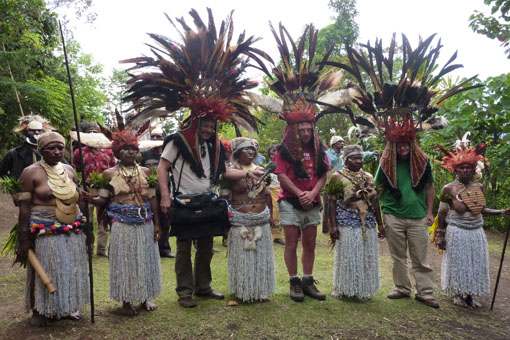
The Music Planet team – engineer James Birtwistle, Andy Kershaw and producer Roger Short – look at the wrong camera while on the job in Papua New Guinea
Yes indeed, as Andy Kershaw tells us on his promo video, filmed recently in Papua New Guinea, he and Lucy Duran are currently travelling the globe for a new eight-part series of world music programmes. Music Planet will be a companion series for BBC One’s major new natural history project Human Planet, presenting the music of some of the cultures featured in the TV series.
As I write, Andy is on his way to Thailand, there to join producer James Parkin and engineer James Birtwistle for a trip that includes Laos and Burma; tomorrow Lucy Duran and I, with engineer Martin Appleby, head off on a rather shorter haul to Galicia in northern Spain - this is for a feature on how the local traditions are influenced by music from across the sea (and did you know there was a mass migration of Britons buying villas in northern Spain in the sixth century, bringing Celtic culture to that part of the world?).
Just as Human Planet shows how people relate to their landscape and environment, in Music Planet, we’re showing how all this is reflected in the local music. So far Lucy has visited Madagascar, Kenya, Greenland and Mali, and Andy has been to the Solomon Islands as well as Papua New Guinea. There’s plenty more before the series broadcasts early next year. If you’re interested, we’ll let you know how we get on…
David and Goliath…
by Robin Cox, Human Planet Cameraman
Mamadou is our “David”. He’s only sixteen, with a small but strong frame, delicate features and a gentle demeanour. He is perfect for the role. Our Goliath is an elephant, a bull, one of a herd of desert elephants that share with Mamadou the watering hole of Banzena on which they both depend for survival in Mali’s arid Sahel desert. His arsenal is just a small handful of sticks.
A year ago Mamadou met his Goliath in a pitched battle on the shore of the lake. Having been without water for two days, his herd of fifty cows were gagging for a drink but the elephants had got there first, and they were not going to move aside. What followed in the moments afterwards we fortuitously captured on film. It was not the story we planned for the shoot, but it was perfect. Immediately after the battle was won, Mamadou and his cattle had drunk their fill and man and cows vanished back into the Sahel. Unbeknown to him, our “David” had been cast, and a mission had begun to seek him out and film more of his story. A search was launched across the many small nomadic settlements scattered over miles and miles of desert. A photo of our wanted man was presented at each stop and finally, after three days, he was found. Unfortunately, though not surprisingly, he was terrified, and he went into hiding for fear that he might be in trouble for his stick missile attack on the elephants. He was soon found again, reassured and eventually talked into letting us tell his tale.
I am here in Mali a year later to finish the sequence. Not present on the original shoot, I am introduced to Mamadou. Like many we have left behind around the world, he has become pretty well versed in the techniques of film making and now, having been able to see the previous year’s results, he is beginning to comprehend what on earth it is that we are trying to achieve. He knows that when I (the cameraman) say “speed” and the director says “action” it means that he should be doing something. Whether or not we have succeeded in conveying adequately what that something should be is another matter! Most of all he knows that hearing the phrase “just one last time” means it will probably not be the last time and it will most likely be ages before we are happy with the shot.
Generally we communicate without words and I act things out or use crude signs… faster, slower, closer, quieter, gentler. It’s a source of constant amusement for all. Much of the communication between us is by facial expression alone. Amusement, bemusement, anger, frustration, exhaustion and a myriad of other feelings are almost always clear to see in each others faces, with no need for translation. These things are universal. With these aids and cheeky smiles, we’ve got to know each other, and had some fun in the searing heat, sandstorms and mud.
Mamadou is in many ways as civilised a young man as you are likely to meet, gracious, kind, and intelligent. He carries himself with dignity despite a life spent in the desert living a nomadic herder’s life which I can only really describe as “old testament”. However he is wholly uneducated, quite unwashed and crudely dressed. Despite all this he is just as much a modern man as any one pacing the streets of London - just without all the gab, garments and gadgets.
On many occasions I have had the notion that I recognise something peculiarly familiar in a person, a characteristic, an inflection in the voice, sometimes combined with a facial expression, and it is like déjà vu. Today I realised that Mamadou is reminding me of someone. As he’s the only African cattle herder I know it’s not somebody just like him, but it is somebody just like him. There’s a theory, so I was once told, that there are only twelve (or was it twenty?) character types in the world. It’s rather simplifying things I know, and I don’t think anyone has ever successfully catalogued them, but my experiences this year of meeting so many far flung strangers have often borne it out. And Mamadou is reminding me of someone.
This sort of thing happens a lot, yesterday for example…. We’re out in the desert looking for lake-bound elephants when Meddi, our local Mali elephant expert, speaks to us through the door of the car. His gun is slung over his shoulder, he’s wearing a long cotton gown and a blue turban, his skin is dark, coarse and leathery from the relentless sun, he looks, and is, utterly exotic. As I listen to the conversation, ears half closed and not understanding hardly a word, I suddenly realise he reminds me so much of an old acquaintance from London, a Glaswegian red-headed accountant. I recognise him absolutely as being just like him, both the same type, and suddenly I know him so much better. Of course, the appearance of the two men could not be more different, but they share the same somewhat glazed look in their eyes, they have the same uncertain smile and both speak with a soft but deliberate tone. Their physiques are even alike, as though their flesh has grown upon their character, they are both lean and stringy. In so many ways they could be brothers.
This phenomenon has happened many times in the past few years with Human Planet and other projects. I have met a Nepalese porter who is just like my Wiltshire builder, hunted whales in Indonesia with a man much like my uncle Malcolm, met a tribal wife in India who reminds me of a nun from my convent school days and fixed fog nets with a Chilean man who reminds me of Pavarotti! I’ve begun to seek out the likenesses. First I recognise something familiar, sometimes instantly, sometimes gradually, then I rifle through the people I know, and have known and try to find the link. With no visual reference I hold up their characteristics in my mind like a photo, seeking out the person in my nomadic life who I know is just like them, though sometimes they fail to come to mind, like a forgotten tune. I am still working on Mamadou, but I know I know someone else just like him and I’m sure he won’t be a cattle herder.
Elephants in the Jungle
by Mihali Moore, Camera Assistant
I thought I had been to remote places in the past, but this trip proved that there is always somewhere further and more isolated than you think. Two flights, a long drive across politically unstable territory, a choice of a four hour trek through jungle or a three hour trip on a rickety truck. An experience that we were told (and can confirm) was like your shirt going through a tumble dryer with you still wearing it! Having trekked for a few hours, it was getting dark and the sound of the truck was music to our ears - or so we thought! After ten seconds of driving aboard, I instantly regretted it. It was terrifying. I lost count of the times I thought it was going to tip over. Perhaps the chap next to me had the right idea. Reeking of whiskey, I don’t think he was worried about anything. Luckily the truck got stuck near the camp and we gladly walked the last twenty minutes by foot. The truck would later be rescued by our pachyderm friends and brought to its final destination.
Nonetheless we arrived safe and sound in the evening to the camp that would be our home for the next two weeks. Our fixer had done an impressive job. We found a selection of individual tents with camp beds, cooking equipment, tables, lights and even power sockets in each one. Mod cons in the deep jungle. Not bad at all!
The next day we met some of the elephants for the first time and carried out a recce of the area for filming spots. I had never been this close to these animals before and was instantly struck by their majestic grace. Wary of our presence, you could tell they knew something was up. We also had the pleasure of meeting the elephant contractor. With his penchant for whiskey and the way the others behaved around him, it was clear he wanted to be perceived as the boss. During our numerous encounters with him, we would find ourselves having to respect his customs and offers of whiskey, whilst listening to his thoughts on what the world would be like without water?!? On the subject of water, it had started to rain. Monsoon season was round the corner and the chances of nicely backlit elephants working in harmony were looking slim.
It was amazing to see how these creatures worked. They can understand up to 65 commands and push heavy logs around as if they were twigs. Each elephant has its own mahout, a young man who perches atop the elephant and ‘drives’ him. Using commands and pressure with their feet, the mahout can direct, steer and command the elephant at a remarkable pace. Keeping up with them wasn’t easy and it’s clear that using the elephant is the only way to get the job done. Ramprashad was our main elephant and he was an impressive size. Whilst slightly apprehensive of us at first, he soon warmed to us and even let us ride him for a bit. In fact all the elephants seemed to accept us quite quickly. At one point I remember standing on a track in a melee of elephants that were trying to push a laden truck up a muddy slope. All I could see was wrinkly skin. I looked at Robin Cox, our cameraman, (to whom I was tethered). He was breathing in deeply and arching his back, desperately trying to fit into a gap between the dense jungle face and an elephant’s belly.
What I found remarkable is the mutual understanding between the mahout and elephant. The elephant will only work for a few hours and if it doesn’t want to do something it quite simply will not. The mahout diligently washes and feeds him each day, which strengthens the bond between the two of them. Each evening the elephant is released into the jungle to roam free. The next day the mahout must look for the animal, which, despite its freedom, won’t have gone far. The chains go on and the elephant knows it’s back to work, a true example of beast and man working in harmony. It was a real privilege to see this unique and rare tradition in action. You’ll get to get to see the reason why we were filming this partnership in 2011. Hopefully we provided a good story for the series!
A Cameraman’s View
by Toby Strong, Freelance Cameraman with Deserts/Grasslands Team
Mongolians, Bushmen, Dorobo and Tubu.
Minus fifty degrees to plus fifty degrees.
Hunters, dancers, herders and traders.
Helicopters, hot air balloons, horses and dug outs.
The last couple of years have given me a breadth and depth of experience that as a young boy I couldn’t have dreamed of.
Thanks to the faith of the grasslands and deserts team I have hunted kudu in the Kalahari; soared over camel trains crossing the Sahara; run on foot towards feeding lions; chased wolves on camel back and caught snakes in a canoe. I’ve danced through the night with the Wodaabe, followed a bird to raid a honey comb and rounded up 2,000 cattle by chopper.
To film all this all this I’ve had toys, lots of toys! (of the highly technical variety)…
Macro lenses, long lenses, time lapse, underwater cameras, infra-red cameras, cameras in helicopters, cameras on rafts, cameras on quad bike, horse back and camel back. Cranes, tracks, jibs, steadicams and hot air balloons.
I’ve travelled to some of the most remote corners of the planet and returned with amazing memories and a few exotic diseases. We managed to knock down a teensy weensy part of a sixth century fort, discovered a carpet viper up my shorts, crashed our balloon and got chased out a hide by a leopard.
Compared to some of the Human Planet shoots, a walk in the park.
So what will I take away from filming on this unique series? Apart from the obvious amazing experiences it will be the shared sense of trying to do something very special with the incredible Human Planet team.
While every tribe I’ve worked with has their own unique and special way of life , I have found two common links between everyone - humour and kindness.
I feel humbled and honoured to have worked on this series and with such wonderful people.
Dale Templar, Series Producer
What Toby is talking about here is common humanity. While making this series we have tried to celebrate the similarities and differences in all of us and I really hope this is played out when people watch the series.
Slip Sliding in Ladakh
by Robin Cox, freelance cameraman, Human Planet
Snow covered our footsteps as we retreated from Pidmo. It had been snowing on and off for a week, the flat roofs of every mud brick house were thick with it and the residents acknowledged our departure as they shovelled their rooftops.
Three days earlier we had advanced downstream on the frozen Zanskar river from Zangla, a mere 8.5km, with the intention that we would progress further the next day to begin our filming. The Chadar, or “sheet” as the iced river is known in winter, had proved to be in poor shape that day. Sections of solid ice gave way frequently to slushy margins and became impassable so we had to resort to the river banks, ploughing through waist deep snow. It was exhausting in the extreme, no step ever finding a sound footing. Two of our heavily laden porters had been ekeing out every bit of open ice when they overwhelmed the thin crust and crashed through. Climbing out, soaked to the skin, they marched on before they froze. No surprise then, that on our arrival at Pidmo morale was low.
The week’s snow had wrecked the length of the Chadar, a hundred avalanches had swooped down onto the ice, puncturing the river’s skin and damming its flow. The pressure then built beneath the surface of the ice and blew huge holes in the ice sheet, as though a giant’s fist had struck it. Water had flooded over the ice, flushing loose shards down stream till they piled up like flotsam against the snowy dam. Some less fortunate than us had been walking on the river when the avalanches occurred. One man, a worker building a new road in the valley, was trapped under an avalanche and sadly perished; others had been forced to wade up to their waists through the icy flood waters to reach safety.
Our mission was to film eleven children and seven fathers as they walked the six day trek along the frozen river from Zangla, a 4000m high mountain village in the Zanskar region of the Tibetan Plateau. Their destination the town of Leh, where the children were being returning to school after the winter holiday. This yearly pilgrimage is routine for the people of the area. The Chadar forms a seasonal highway through stunning gorges, allowing relatively easy access out of the mountains, impossible by road during the winter months when the mountain passes are closed by snow. It is usually traversed without great difficulty and we ourselves had walked upstream on smooth firm ice just a week before with smiles on our faces. The river had been alive with local people marching in both directions, carrying goods of all kinds.
We had been told that in living memory there had been no deaths in avalanches and only two deaths due to drowning when the ice had given way in the spring. We had felt confident that our return trip would be just as easy. To be extra cautious we had left an extra week to make it down the river well before the end of February when traditionally the ice begins to melt and the Chadar becomes perilous. This year the un-seasonal snow had changed everything, and it began to seem as if our film was ill-fated.
Now we found ourselves in retreat - a great caravan of fifty porters carrying our 600Kg of film kit, camping gear and supplies. Days earlier when we started optimistically from Zangla, we had begun to hear the bad news… ‘the worst Chadar I have ever seen’ said one local when we arrived in Pidmo and dissent began to spread through our porters. A meeting was held with the fathers and guides while the porters had their own out in the snow, a shop stewards meeting of a kind. The consensus was not good, nobody was willing to go further so a retreat back to Zangla was the only option.
The river was torturously hard going so we walked on the road, relentlessly trudging in deep snow, navigating a path by telegraph poles, a beaten army returning from battle. The 8.5km took an aching six and a half hours; it was last light as we clawed our way into Zangla and back up the steps of Stanzin’s house, one of the fathers with whom we were staying. We collapsed - the altitude and snow had pushed us to the extreme. Too breathless to talk, David the director asked me to phone the producer, Mark Flowers, back in the UK to let him know of our retreat. Over the next 24 hours a plan to evacuate by helicopter formed and we contemplated abandoning the film.
There was only one chance to save the situation. The fathers told us that given a good spell of clear cold weather, just maybe the ice would heal and we could try again. We decided to sit it out. Next morning the sun shone in a deep blue sky. Hopes were raised and rescue postponed. One clear day followed another as we eagerly awaited news of an arrival from downriver that would signify it was once more passable. We played ball with Stanzin’s daughter and son, Dolkar and Chosing, on the rooftop whilst our guides kept an eye on the distant river. We washed our stinking thermals and waited… but no-one came.
Fears grew that the Chadar was finished for the year. We were washed around in a sea of consternation, trying to find a way to rescue the film before we were evacuated. Finally we formed a plan: we would film with just Stanzin and his two children walking as far as they could before being forced to turn back by the obstacle that lay somewhere downstream… at least we would have something to show for our toil. So three days after returning beaten to Zangla we set out once more for the river. We followed the trail of a snow-plough clearing the route to the road builders’ camp to bring home the dead worker’s body. Like a funeral procession, we followed the rattling machine to the ramshackle camp; the atmosphere in the camp was sobering. The porters again began to lose heart and more negotiations followed. Having successfully talked them round, we set out early the next morning.
It was icy cold, -30C, a bitter but sweet climate in light of our prayers for the Chadar to be safe. We clambered over the avalanches in silence, spread out to minimise risk, and advancing as fast as we could to get past the east facing slopes before the heat of the rising sun caused further falls. By lunchtime we had arrived safely back on the frozen river. The section we found ourselves on seemed solid enough, but as we ventured downstream the havoc the avalanches had wrought on the river became obvious, and there were still monumental obstacles out of sight for still no-one appeared from downstream. We filmed for two days, making the most of the weather until we reached a pool of open water only negotiable by means of clambering over a narrow rocky ledge. What seemed impossible for us to negotiate, seemed a breeze for the kids, but we felt we could go not go further with our equipment and returned to camp for the night. It seemed our story was over, all that remained to do were a few shots the following morning and then we would retreat to await the airlift. We had done our best in the circumstances.
I awoke the next morning to the familiar sleeping bag, iced by my night’s breath. There was much chatter in the camp and the chef was singing and shouting, which was not unusual, but there was a good vibe in the air. We gradually surfaced, squeezing into our rock hard boots and many thermal layers. Nick, the sound recordist, (always first into the mess tent for hot tea with chef) was greeted by good news. Max, David and I joined him and heard it too. That morning, at the crack of dawn, two men had arrived from down river, they had made it, the ice was apparently back, rough in places but sound and passable… suddenly our story was saved. Later that morning, twenty-one days after leaving Leh, we began to walk the Chadar to school with Dolkar, Chosing and Stanzin and the real film began. I have never known such a roller coaster of a shoot, or ever been away so long and achieved so little with the very real prospect of coming home empty handed.
We reached the school in Leh on the last day of the holidays and proudly sent Dolkar in her crisp new uniform with her brother through the school gates to begin their new term. Mission complete, we headed for the comfort of a hotel. Father Stanzin turned on his heel to start the return trip back to Zangla. He was only halfway through his journey, but as usual he took it in his stride.
Life is all about packing cases
by Jasper Montana, Technical Coordinator
Metal pins are slowly spreading across the map of the world in our office – each one representing a trip, a recce, a shoot, and another sequence of Human Planet recorded onto what have now become many kilometres of magnetic video tape. For each of us on the Human Planet team, each pin represents a different moment of time.
For those who went on location, it may be a life changing adventure, a harrowing experience, or a drop in the ocean. For those left in Bristol or Cardiff, it might be a sigh of relief as the crew depart, a moment of pause in a quiet office, or a stressful planning process which lingers long after the crew depart, when phone calls from the Jungle require a mortally wounded shoot to be remotely stitched back together.
On many occasions the pin represents for me long days of getting a plethora of filming equipment squeezed into the smallest possible cases for transport to location. So I was going to write a post about how the human desire to make order out of chaos can be summed up in the line ‘life is all about packing cases’ but I thought I’d just make a time-lapse video instead.
Enjoy.
Packing cases for a shoot to Algeria - timelapse video coming soon
Only a handful of pins are left in the jar – who knows what each has in store.
A Year on Human Planet
by Willow Murton, Assistant Producer, Oceans/Jungles team
9th October 2009
This time a year ago, I flew to La Paz in Bolivia, the highest capital city in the world and there, short of breath and cheeks full of Andean colour, I began life on the Human Planet team. I type this blog now under the stifling heat of the Algerian Sahara, many miles from those early cool heights.
Sometimes it is good to stop and reflect. There has not been much time over the last year for moments to look back – so much looking forward into the matrix of kit lists, itineraries and budgets that the months and the countries can go by.
This October evening, we gathered on a carpet outside under the date palms and the eager gaze of the local well workers who we have been filming with. Swirls of white turbans and the excited movement of children surround a small screen as we play out clips of what we have filmed over the last few days. They watch the images and the sounds they have patiently repeated in order to get just the right shot, in the right light. They laugh and we relax. This is one of the best moments of film-making, sharing the work of crew and contributors. We hope all our ridiculous demands make some kind of sense when seen on screen, and we too begin to understand more as questions bounce between us.
The claustrophobia of the small tunnel where we have been filming opens out into the warm evening. Small glasses of sweet mint tea are passed about amongst the comments. Filming is a demanding and long process which the workers have participated in with huge patience and good humour. In order to give them a glimpse of how the final film may come together, as well as a chilly insight into another underground world, we put on an edit from an Arctic sequence. There we are, warm in the evening air, watching people wrapped up from icy cold. There are gasps when I say that the temperature there is thirty degrees below Celsius. The days here in the desert are usually thirty degrees above and not unusually much higher. Beneath the arid surface of the Sahara, the workers here have dug through thick red clay to make tunnels to feed an ever-growing irrigation system. They cannot believe the effort of these distant Arctic dwellers as they dig into frozen crevasses. They are even more incredulous when they realise why. What the Inuit consider a gastronomic delicacy, the workers of the Sahara struggle to imagine edible. The frozen walls of an igloo protecting those inside from the cruel cold of the Arctic belong to another world, far from the rich red buildings of this small village, where people seek shade from a relentless burning sun.
Yet, further North, the Arctic is beginning its own dark turn to the winter once more. This year on Human Planet has spanned continents and captured moments of incredible feats, emotion and beauty. As the workers leave to sleep before they are called to prayer again and back to their work, I contemplate a year which has taken me to a frontline in the Simien mountains, above Greenlandic glaciers, into the path of avalanches, under sea ice and onto its floe edge, from Arctic darkness to midnight sun, from the green of a desert oasis to the barren hillsides of a Caribbean island. Like the Andean heights where I began, it takes my breath away.
Fumble in the jungle
by Tom Hugh-Jones, Producer/Director - Oceans and Jungles team
I know that working on Human Planet is supposed to be a dream job and don’t get me wrong, I love what I do, but it doesn’t half try your nerves sometimes. This is definitely not the right career path for those who suffer from stress and nothing proves my point better than my recent experiences of filming in Jungles. I’m sure some people will disagree, but for me this has to be the most challenging environment to work in.
For a start the weather is just too unpredictable. Ok, so you know it is going to rain, but you don’t know when or for how long. Every day we seem to be in a never ending cycle of setting up kit ready to shoot, only to have to pack it up again as the next rain storm passes by. Rain is an ever-present menace, but it’s the 100 % humidity that causes the serious problems. Not only does it make for unbearably sticky working conditions, it also has the habit of rendering our equipment totally unusable. Our extremely expensive camera lenses constantly fog up, making it look as if everything’s being shot in a misty 70s dream style. No big deal, an hour of clenching the lens in the warmth of your groin area solves that issue. The light is better now anyway and god knows what the tribe is doing, but it looks amazing…..OK, let’s shoot! But wait, not so fast! what’s that flashing red light on top of the camera? Oh yeah, that’s the humidity warning and now our only option is to pack the camera body away in a hot-box for a day to drive out the condensation. Well, never mind, there’s always tomorrow.
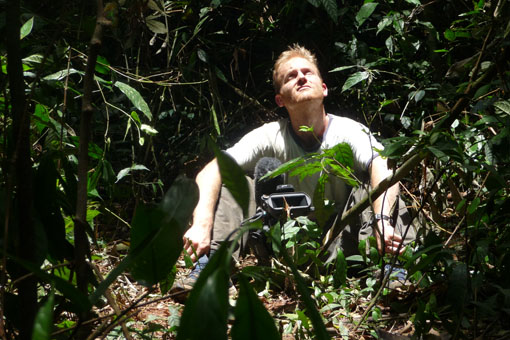
Drying the camera in the sunshine
After a wet night we get up ready for action, only to find that now there’s an even more serious technical issue that’s beyond the cameraman’s fixing abilities. This is when the next jungle challenge presents itself. Jungle locations are invariably very difficult to access, making communication with the outside world close to impossible. When things break, trying to get replacements sent in usually means sending some poor local person off on a three day hike to the nearest village to meet an aeroplane we’ve had to charter at great expense.

Everyone waiting
It isn’t just kit that falls apart in the forest; it’s the crew as well. Rain and sweat combine to ensure your clothes and shoes are never truly dry and pretty soon the rot sets in. Any minor cuts from the myriad of spikes and spines you inevitably encounter soon becoming gaping septic wounds. And to top it all there’s the constant assault from leeches, ticks, mosquitoes and all sorts of other unidentified parasites that are after your blood. With every daily wash I seem to discover a new colony of animals that have chosen to make their home on my body.

Insects attack
Each time I go on a trip in the rainforest, I swear I’ll never do it again, but somehow I keep on finding myself coming back for more. After I’ve got back home, slept in a proper bed, had about ten baths, been to the doctor to get my various tropical infections treated and then put in my insurance claims for all of our broken cameras; I begin to realise it is all these trials that make for my most cherished memories of filming for Human Planet.
My latest trip to film with the Korowai tribe of West Papua was a perfect case in point. We had all the usual battles with the elements, technical glitches and medical mishaps but having the opportunity to spend time with this tribe was perhaps my most amazing filming experience ever. Although their culture is about as far as you can get from our western world, the Korowai welcomed us into their lives with amazing warmth and it was just incredible to see how they managed to live such rich lives with nothing but what they found in the forest. What’s more I think we got a pretty stunning sequence but you’ll have to judge for yourselves when Human Planet comes out in 2011.
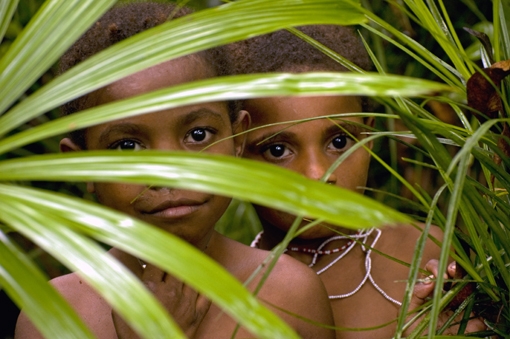
Korowai Children
Dale Templar - Series producer, Human Planet
I have no real idea what Tom is moaning on about! He’s clearly not been in the UK enough this summer. Based here in Bristol most of the time I am beginning to wonder if we’ve been secretly transported to the tropics. I’m finding it impossible to plan anything outdoors; lots of crazy unpredictable rain, some of it torrential; lots of bugs (swine flu is rampant). The only big difference is that it’s so cold and I hate the cold. Summertime in the British urban jungle is not without its frustrations!
Teams everywhere on location
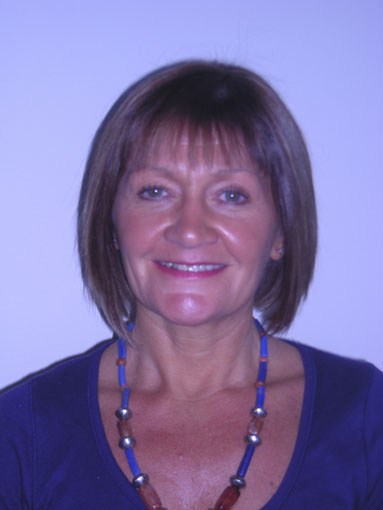
by Ellen Davies, Production Manager, Arctic/Mountains team
My location is Cardiff and my office is on the top floor of BBC Wales which overlooks Llandaff Cathedral. Here I enjoy the comforts of my work place where so many of our day to day facilities are taken for granted. I’m comfortable. One of my teams are currently in Greenland, the other is about to head off to Mongolia (for more see below my blog). Geoff from BBC Shipping has a very soft, gentle voice and says: “Calm. Calm.” It works. I’m now calmer and I’m in the process of freighting my second shipment of kit to Qaanaaq, the most northern town in Greenland. Geoff simplifies the process.
We hire, purchase, gather and pack our kit with our wonderful Patrick Murray, Cardiff’s Technical Assistant on Human Planet (what would we do without Patrick?). For Greenland this includes a crane with hothead, a kayak with specially designed rig, camping gear, cameras, sound, first aid kit and enough warm clothes and sleeping bags to make sure the crew don’t freeze.
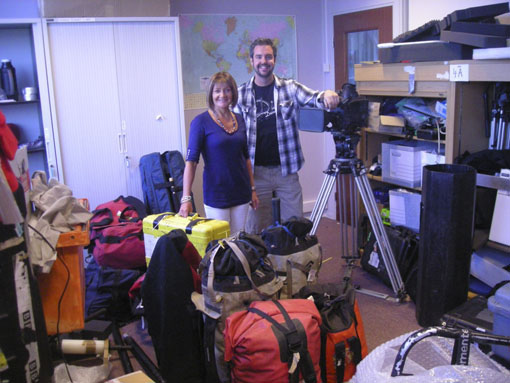
Ellen and Patrick and kit bound for the Arctic
Getting the kit to our destination is quite straightforward – from Heathrow to Copenhagen to Kangerlussuaq to Illulissat to Pituffik to Qaanaaq and onto Siorapualuk. Easy. (I can even pronounce these names now!) The kit gets there. It takes two days. The last ride is by helicopter where you would fly along the rocky coast line over icebergs and fiords. It must be pretty spectacular. The third shipment of kit travels with the crew and I’ve only booked a seven seater people carrier to transport three people and kit! Where and how do we accumulate so much? We’ve now exceeded over 1000 kgs of kit. The Arctic crew are out of the door and I’m already on the next shoot for the Mountains programme….
My Greenland team are filming two stories for the Arctic episode and one involves filming on sea ice that is starting the break up. Because of the dangers of trying to film the narwhals (sea unicorns) from the kayak and on the ice edge, we have a strict protocol – Bethan Evans (researcher) or Nicolas Brown (producer/director) must call me at 16.00 hrs daily. If I don’t hear from them after four hours, I then make contact to their local police. I look forward to my cup of tea after I’ve received their phone call. I can relax for another day. My schedule and two mobile phones rest on my bed side table and I warn my husband that I might just get a call. I put my phones on silent but vibrate.
Sometimes I wish I was the one going on these amazing filming trips but generally I enjoy being on the end of a satellite phone, the welcome voice of home for the guys on location. By working on this series I’ve really come to understand the incredible way people live in these remote environments. More than ever I appreciate the comforts of my home, my family and friends and the BBC office. Roll on 2011, when I will enjoy watching the fantastic footage and amazing stories on my 52” plasma screen in HD!
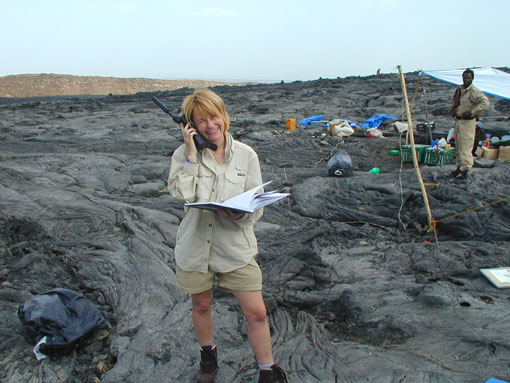
Dale Templar, Series Producer, A Return to the Last Disco in Mongolia
I don’t get out much these days, one of the few down sides of running Human Planet. On Sunday I am due to return to Mongolia to film golden eagle nests. I say “due” because I’ve just had a phone call from Dina, our researcher, to say the eagle chicks we wanted to film have been taken! Poor Dina! As I write, there are men on horses galloping around the western Mongolia mountains looking for eagle nests. They are seven hours ahead and if there is no joy soon we may have to cancel the shoot.
Anyway, back to my original story. If we do fly on Sunday this will be a strange return. The last time I filmed in Mongolia was in 1993, soon after Russia pulled out of the country. It ‘s still one of the most God forsaken places I have ever visited. The economic rug had been pulled from underneath the country - they’d been left abandoned. Ulaanbaator was a sad, bleak capital city filled with stark Stalinist buildings, empty shops, abandoned hospitals and truly disgusting food. No longer needed as a buffer zone with China, they’d been left to start again.
I had gone to make a film with Fergal Keane about the sewer children and spent a fair bit of time underneath the rat ridden streets of the capital. We had knives pulled on us, stones thrown at us, sewer covers slammed on us……. umm Mongolia, can’t wait to return. Thank goodness for the disco at the Ulaanbaatar Hotel !
Seventeen years on, I’m told Mongolia has changed significantly. I actually can’t wait to see it. The boy I filmed was called Batzayan, he will now be a man. Hopefully he will be successfully forging his way, feeding his children and keeping them warm as this now established democracy pushes open the doors of the market economy.
Singing in the Rain
by Mark Flowers, Producer/Director Rivers/Urban team
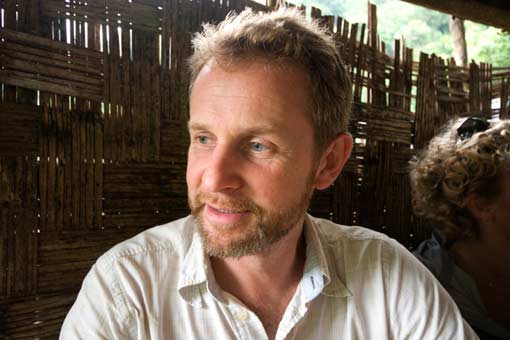
The most heart-stealing and downright soul- enhancing benefit of working on a Human Planet shoot is the children we encounter while we are filming. It’s unbelievably refreshing to step outside of a regulated, fast-paced and impersonal modern, urban society and meet people who live in a more open, communal and for me personally, a far more “Human” way.
The children we met during our trip to film living root bridges in one of the most remote areas of North-East India were fantastic - cheeky, smart and funny.
To the young people who live in isolated hill villages in the rainforests of Meghalaya, the arrival of a gangly bunch of giant, pale-skinned strangers, brandishing weird black boxes, screens and cables, was the most surprising thing to happen in a long while. The circus had come to town!
Within minutes of us stepping out of the cars, there were bright eyes at the windows and small hands waving from the homes we passed. High pitched “hellos” echoed all around while tiny toddlers stood dumb struck for a few seconds in doorways and then exploded into howls. Dogs barked and sulky, caged cuckoos crooned from dark corners.
Whenever we set up to film very quickly we were surrounded in a small lava flow of children, far to shy to talk to us individually, but en masse, well that’s different, isn’t it? Whenever we got the camera out we were mobbed!
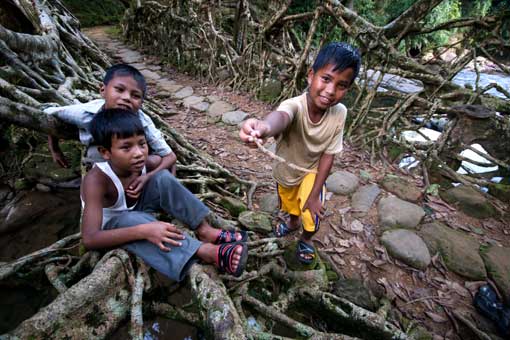
- Smiling to camera
The funny thing was that we were hoping to shoot short stories for our sister production, working title “Little Human Planet”, showing how children live in different parts of the world. This depended on the little people we were hoping to film behaving as if the camera wasn’t there: Fat- chance!
We soon realised that if we were to get any shots that looked even vaguely natural, the crowd of children needed to be distracted, and that meant entertaining them. Guess who had to do the entertaining: Me. Yikes!
Just so you know I am a greying man in early middle age. I am not a totally serious person but as a director on location I have a role to play out, a reputation to maintain. I have to be seen to be in charge! Usually you’d find me in earnest conversation with the team, or looking sternly down my monitor checking that each shot is right.
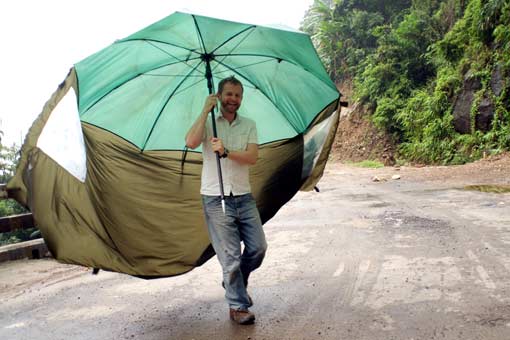
Singing in the rain
I didn’t have a white rabbit, I don’t know any tricks, so the only thing I could think of to do instantly was to sing! it was raining too , I had an umbrella – so I started with “I’m singing in the rain” but soon moved on to nursery rhymes to keep the “show” on the road.
I am not sure if the footage of the crowd and the children will end up being used as everyone looks very surprised or is laughing, but the most magical thing is that the little children joined in with me. Incredibly in such a remote part of the world they knew “Baa Baa black sheep” and “Twinkle Twinkle little star”! The memory of singing in the rain with little children holding technicolour parasols is a memory I will always cherish.
Here is a clip. Unbeknown to me, Richard our cameraman turned the movie camera on me and caught me during my act. Enjoy!
[bbc-bc video=21316429001]
Cold hands, crazy cranes and frozen fish

Bethan Evans, Researcher
by Bethan Evans, Researcher, Arctic/Mountains team
As the “cold” researcher for the Arctic programme of Human Planet last month I was lucky enough to find myself in a tiny village on the West Coast of Greenland. With our small crew we were in search of the elusive Greenland shark, known to Greenlanders as Eqalussuaq It’s one of the largest sharks in the world and the only species living in Arctic waters. The Greenland shark lives in deep water, rarely seen near the surface, preferring the frigid cold at depths of up to 2000 metres. As the sea ice melts, local fishermen start seeking it out and we wanted to film their search.
Filming in the Arctic winter is incredibly tough, that’s without the prospect of trying to film an elusive shark that is particularly camera shy! Try passing the cameraman delicate lens tissue and filters while wearing three pairs of gloves. If you do risk taking them off, your fingers freeze to the filters’ cold metal casing.
Or try to keep your crew happy at lunch when their sandwiches have frozen into a solid block!
But throw in a camera crane and an inventive crew and the frozen fun really begins! In order to get some great shots of our fishermen, Amos and Karl-Frederik (a father and son team), we decided to set up the crane over an ice fishing hole. They were busy fishing there for halibut, before turning their attention to sharks.
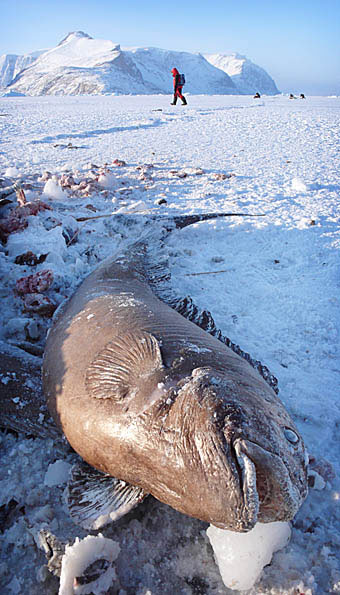
A useful find
The crane works on a counter-balance system so we had planned ahead and hired gym weights from the nearest town. Unfortunately we didn’t have quite enough weight, making the crane difficult to manoeuvre. We scoured the bare, white landscape desperately looking for something to use as a weight. Eventually one of the crew spied a hapless frozen fish which had been lying next to an old fishing hole for days. In Inuit culture every part of a caught animal is used, so in true Arctic spirit we decided this fish would be put to use.
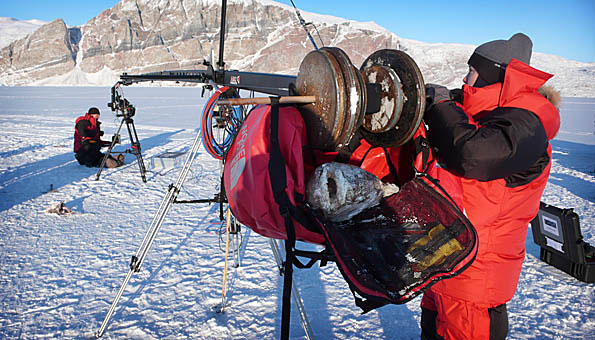
Tipping the balance
The large and quite frankly extraordinarily ugly fish was hauled off the ice and heaved into our medical emergency bag. The bag was emptied of all life-saving equipment to make way for Freddie the Fish. Happily the fish, after a bit of modification, was just the right weight to balance the crane and we carried on filming, much to the amusement of the Greenlandic fishermen.
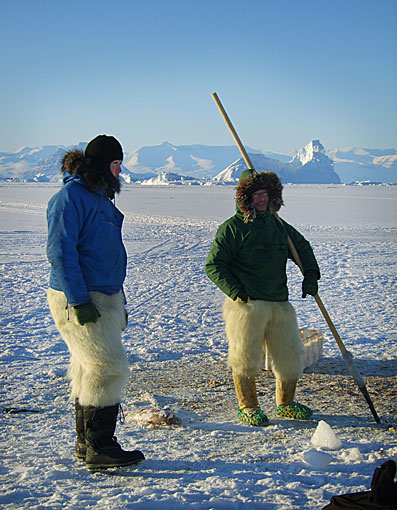
Karl-Frederik and Amos in polar bearskin trousers
…………………………………………………………………………………………………
And finally…..
It’s been another busy month on Human Planet. Our Deserts team are just about to leave for Mali to film a fascinating story about elephants. It is always difficult trying to keep up with the crew in the field in these remote locations . We spend lots of time struggling with Sat phones, as satellites move away and break signal at the crucial moments. “You want a Doctor?…” Crackle , splat…10 minutes later as another satellite cares to drift into sat phone sight lines and we are all ready to contact the BBC Health and Safety Department… “Oh! You want Doctor Who recorded, no worries” . However, when I spoke to director Nick Brown from high in the Ethiopian mountains recently, he sounded as clear as a bell . It must have had something to do with being so close to those satellites!
Dale Templar, Series Producer
Welcome to Human Planet
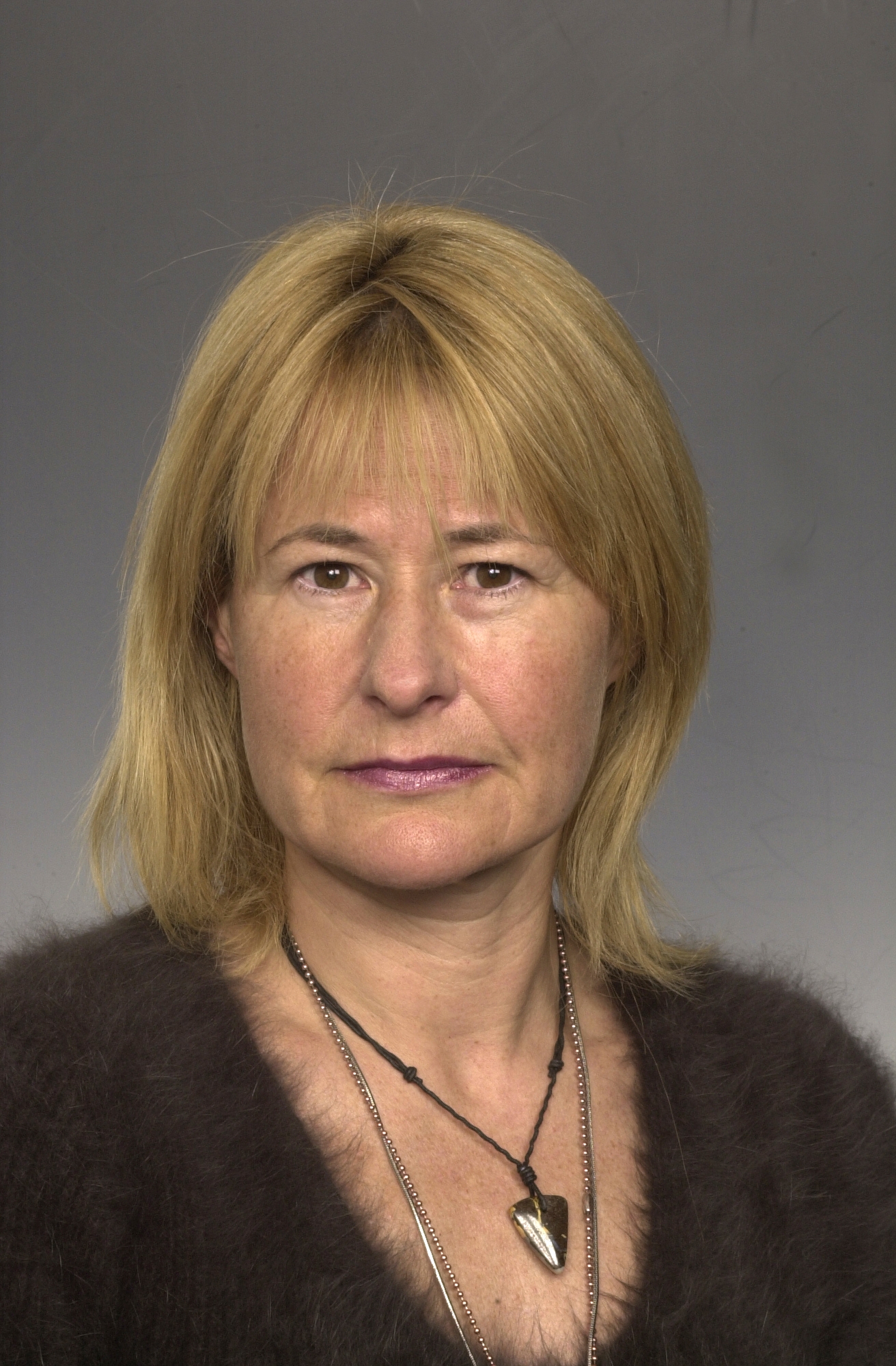
Dale Templar, Series Producer
by Dale Templar, Series Producer
So what is Human Planet? Human Planet is a new 8×50 minute landmark documentary series being made by BBC Television. The series celebrates the human species and looks at our relationship with the natural world by showing the remarkable ways we have adapted to life in every environment on earth. It is due to be transmitted in the UK in the New Year 2011 and will be rolled out across the world soon after.
The production team is split across two sites, one in Bristol and one in Cardiff.
In BBC Bristol we are part of the world renowned Natural History Unit. You may have heard of us, but if not, you’ve probably watched some of our programmes. Many have been presented or narrated by Sir David Attenborough, like Planet Earth and Blue Planet. Most recently we’ve just finished Nature’s Great Events which our own executive producer, Brian Leith, worked on.
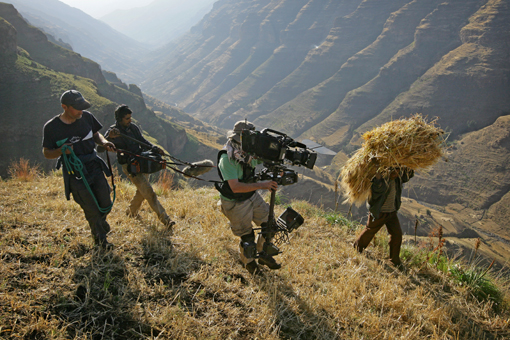
BBC Human Planet : Simien Mountains
BBC Wales, based in Cardiff, are probably best known in the UK right now for producing high end popular dramas like Doctor Who. Torchwood, another sci-fi doc that comes out of Cardiff, is also an HD production and Human Planet will be using the same excellent post-production facilities. The factual department is best known for its ground-breaking anthropology documentary series Tribe.
In total we have a core team of 20 phenomenally talented programme makers, who come with a wide range of skills and experiences. Working with us are some of the best wildlife and documentary camera crews and fixers in the world. For the first time we have a dedicated stills photographer, Timothy Allen, who will be posting his own Human Planet blog every week at http://timothyallen.blogs.bbcearth.com/
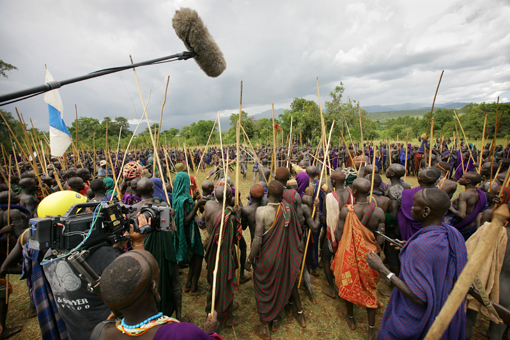
BBC Human Planet : Suri stick fight
The series started in full production in the summer of 2008 and we will be shooting over 70 stories in some of the most remote locations on earth in around 40 different countries.
Each episode will focus on one single environment: desert, jungles, arctic, grasslands, rivers, mountains, oceans and urban. Many of the stories are extremely dramatic and will show how we have successfully adapted and survived in the most challenging places on the planet.
As from next week each member of the team will be blogging their stories from the Human Planet. I will keep you updated on where everyone is and give you general news about the series.
Currently, we have teams that have just come back from the remote southern region of Mongolia, filming for the desert episode. On location are the Jungles and Mountains team who are in the Central African Republic and Nepal. I’ll let you work out which team is where!
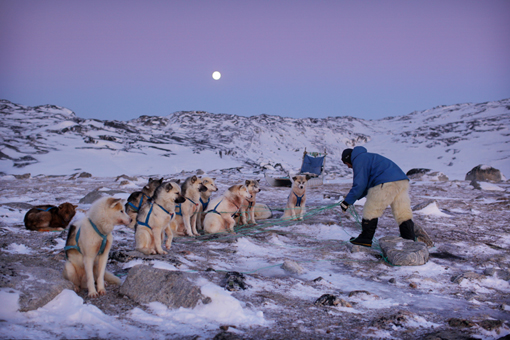
BBC Human Planet : Arctic Dawn
That’s it for now …enjoy the photos and the sneak preview from the series. See the link if you’d like to read what Timothy Allen’s been up to and don’t forget to explore the new BBC Earth site too. Look out for the regular Friday posting from the Human Planet team, with fascinating stories and tales from both our many locations and from the office.
A Grass Calendar
Jane Atkins, Researcher, Deserts/Grasslands team.
A waving white flag is usually a sign for peace, but in the Omo valley it was quite the opposite. In a vast valley of green grasslands and leafy trees these bright flags stood out as bold signs announcing that a violent stick fight was being planned between two villages. It was these incredible stick fights, or Dongas that we hoped to film - but finding out exactly when they would happen was a bit trickier! With only a ten day shoot in this massive valley that stretched to Sudan, we had to find out when each Donga was taking place, and if the chiefs of each village were happy for us to film.
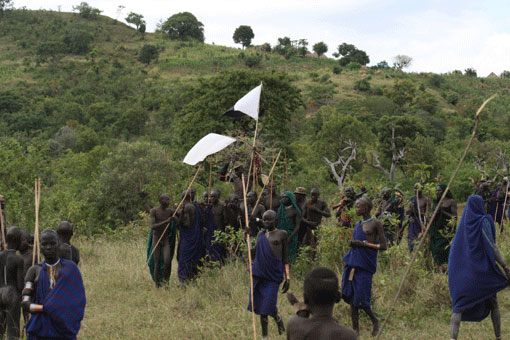
White flags waving
Luckily we were working with Zablon Beyene, an incredible person and wonderful fixer, who introduced us to wise old chiefs and proud confident warriors with smiles.
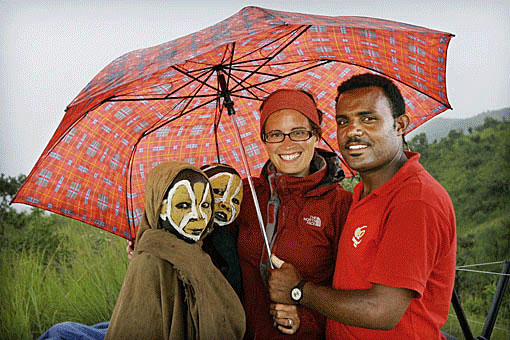
Zablon and I share our umbrella
Over a 5 day recce we walked through villages and valleys to meet Suri elders, sat under shady trees in the heat of the day to talk to young fighters, and sketched out a badly drawn and dusty map of which villages were planning Dongas.
Sitting on the grass, with my map in my dirty hands, we just needed to mark it according to our western agenda of time. Diary planning and meeting deadlines becomes second nature in TV, but here dates were less clear, even to Zab! When we asked the chief when the Donga would happen he picked a long stem of grass, and with dark, leathered hands and tied evenly spaced knots. He explained how each knot represented one day, so the grass stalk handed to us with 8 knots meant the Donga would be on the 8th day. With slight apprehension I translated the dates onto my map, and thanked the chief. Now, after hundreds of handshakes and Suri meetings, all that remained was getting the camera crew to the right location.
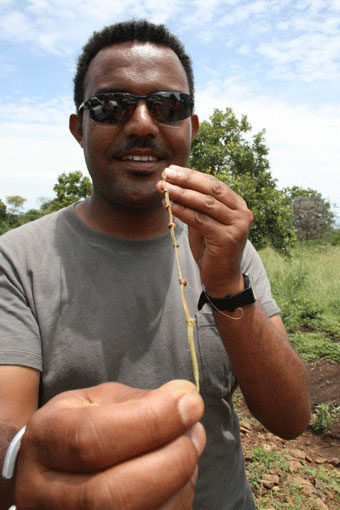
The knotted rope calendar
On the morning of the Donga we walked to the clearing - it was silent, except for the sound of hundreds of dragonflies buzzing around in the sun! 2 hours later, with all our camera kit ready and a crane rigged, we looked at the empty clearing and hoped we’d got the right day after all!
We heard the men coming before we saw them; chants and songs through the trees, getting louder as they approached. Then gun shots! This, Zablon told us, was just guys firing shots into the air to psych themselves up. It worked, as the air was suddenly filled with excitement and adrenaline, as hundreds of men poured into the clearing, waving their sticks. As the crowd circled two posturing fighters, they stabbed a white flag into the ground; the donga had started.
To set the scene our cameraman Mike Fox moved the crane 20 feet into the air to reveal an amazing image of hundreds of men in combat - a scene you’ll never see any where else. We filmed all day, with the crane, then moving hand held amongst the crowds and spectators, and also with an incredible high speed HD camera that captured the force of each fighter. Moving through pumped up crowds, dodging swiping sticks, and ducking from celebratory gun shots were part of the experience and chances we took to film the sequence.
As I led a cameraman into another position I was mistakenly hit by one stick, and as I ran for a new battery I heard the whizzing of a gunshot past my head! The brutality of the Donga really did separate the men from the boys, and was a fascinating insight to the Suri world. As we packed up I was happy that all our planning had paid off, but even happier that we’d all survived!
